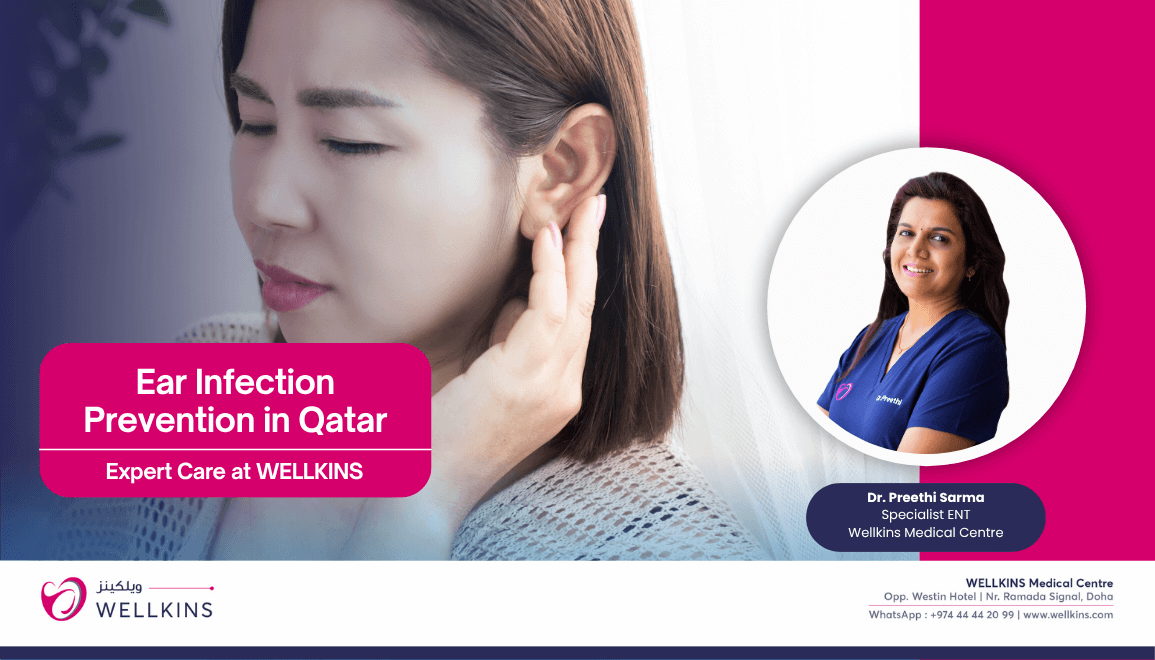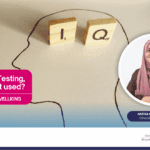Author: Dr. Preethi Sarma (Specialist ENT – Wellkins Medical Centre)
Ear infections or Otitis, are a frequent source of sharp pain and intense discomfort for people of all ages, though they are particularly notorious among young children due to their unique anatomy. A simple earache can quickly turn into a devastating sleepless night and a difficult, fussy day for the whole family. Otitis can impact hearing, balance and general well-being. Not all earaches are the same. The term “ear infection” is broad and often misleading, as inflammation can affect three distinct parts of the ear, each with a different cause, set of symptoms and treatment. Knowing the precise anatomical location is crucial for us to diagnose and treat the cause correctly and efficiently.
“Effective management of ear infections relies on addressing multiple factors, from correct medical treatment to controlling moisture and exposure. Navigating recovery and prevention in Qatar requires proper guidance, encompassing hygiene and device use. Since underlying issues like trapped water, foreign objects and device irritation are all linked to ear infections, a well structured plan that includes diagnosis and lifestyle changes is essential for the long-term journey of protecting your ear health, not just masking the pain or infection.”
1. Outer Ear Infection (Otitis Externa or “Swimmer’s Ear”)
This infection specifically affects the ear canal, which is the passage leading from the external opening of the ear to the eardrum. It is essentially a skin infection of the external auditory canal.
Cause: This condition is frequently caused by water trapped in the ear after swimming, showering or bathing, which creates a warm, moist and dark environment perfect for bacteria or fungus to thrive. Furthermore, aggressive attempts at self-cleaning with cotton swabs or sharp objects can cause micro abrasions to the delicate skin lining, allowing infectious agents to enter easily and initiate the inflammation.
Symptoms: The defining symptom is pain that is excruciatingly intense when the outer ear or tragus (the small cartilage flap just in front of the ear opening) is touched or pulled. The skin of the canal becomes swollen and red and a watery or thick, pus-filled discharge (otorrhea) is a common sign. Often, patients report a feeling of “blockage” due to the swelling.
2. Middle Ear Infection (Otitis Media)
This is the most prevalent type, affecting the small, air-filled space located just behind the eardrum, which contains the tiny hearing bones (ossicles).
Cause: Otitis Media almost always occurs as a debilitating sequel to an upper respiratory infection (cold, flu, sinus infection). Viruses or bacteria from the throat or nasal passages travel up the Eustachian tube, which connects the middle ear to the throat. The infection causes the tube’s lining to swell and block, creating a vacuum that draws fluid from the mucous membranes, leading to pressure and subsequent infection as trapped germs multiply rapidly.
Symptoms: Patients experience intense, deep, throbbing pain or pressure inside the ear, known as otalgia, often accompanied by a significant, noticeable muffled hearing sensation. Fever is a very common systemic sign. Young children, unable to communicate their pain, may manifest with telling signs like persistent pulling, batting or tugging at the affected ear, increased fussiness and notable difficulty in sleeping, especially when lying flat, due to increased internal pressure.
3. Inner Ear Inflammation (Labyrinthitis or Vestibular Neuronitis)
While this is technically an inflammatory condition of the delicate inner ear structures, the labyrinth (cochlea and vestibular system) rather than a direct bacterial infection of the tissue itself. It is usually triggered by a preceding severe viral illness (like a bad cold or flu).
Cause: The condition involves viral infection or intense inflammation of the nerves connecting the inner ear to the brain (Vestibular Neuronitis) or the entire inner ear organ (Labyrinthitis). This inflammation disrupts the signals related to the body’s position and motion.
Symptoms: This condition is primarily characterized by severe disturbances in balance and spatial orientation. Key symptoms are severe, debilitating vertigo (a sensation that the room is uncontrollably spinning), significant dizziness, loss of balance, acute nausea and often uncontrollable vomiting. Labyrinthitis specifically includes auditory symptoms such as persistent ringing in the ear (tinnitus) or sudden, fluctuating hearing loss, differentiating it from Vestibular Neuronitis, which typically affects only balance.
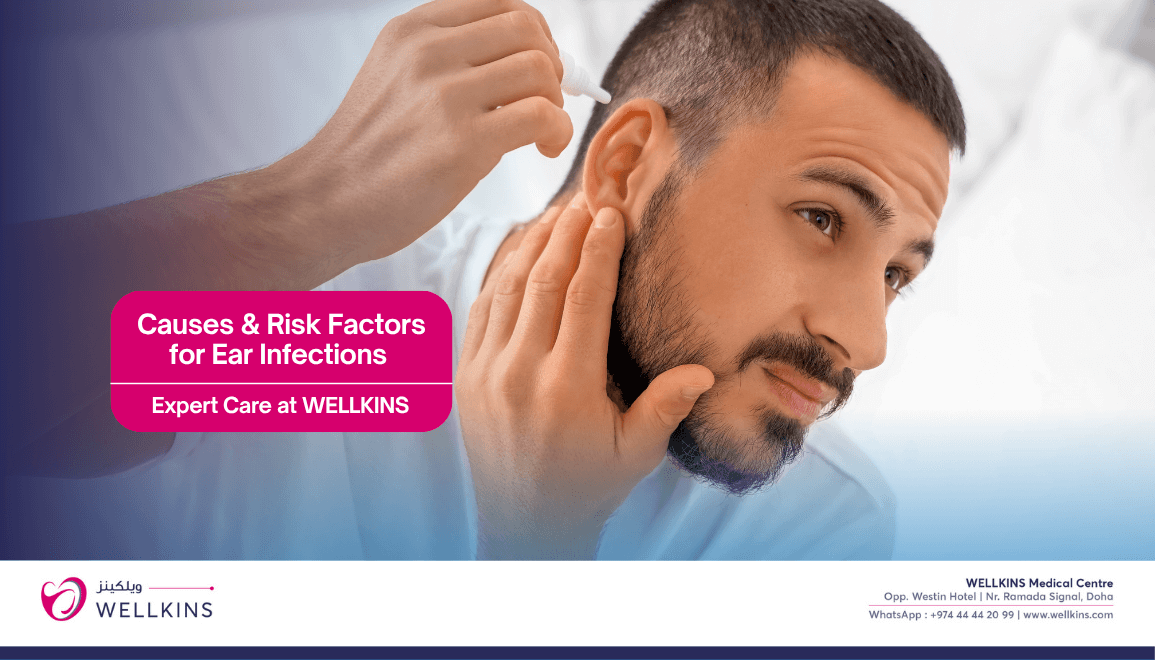
Causes and Risk Factors for Ear Infections
Understanding the multifaceted reasons why ear infections occur allows for targeted, effective prevention and risk mitigation strategies.
Upper Respiratory Infections: Colds or the flu are the primary cause. Inflammation and mucus from a URI swell and block the Eustachian tube, creating a sealed, negative-pressure environment that traps fluid and allows germs to rapidly grow in the middle ear.
Age and Unique Anatomy: Children under five are the most vulnerable. Their Eustachian tubes are shorter, narrower and more horizontal than adults’. This anatomy makes them less efficient at draining middle ear fluid, leading to easier infection.
Chronic Allergic Inflammation: Persistent nasal and throat allergies (like allergic rhinitis) cause constant, low-grade swelling. This prevents the eustachian tubes from opening and closing correctly, resulting in chronic fluid trapping and repeated middle ear infections.
Environmental Toxin Exposure: Exposure to second-hand tobacco smoke is a major risk. Smoke directly irritates the respiratory tract and paralyzes the cilia (tiny hairs) that sweep fluid and debris out of the eustachian tube, drastically increasing the risk of fluid accumulation and infection.
Water Contamination and Skin Trauma: Frequent water exposure (pools, lakes) is the main risk for Otitis Externa (Swimmer’s Ear). Excessive moisture breaks down the skin’s protective barrier, while aggressive cleaning with cotton swabs causes microscopic trauma, providing a direct entry point for external bacteria.
Group Settings and Immune Maturity: Attending daycare or school greatly increases exposure to the viruses and bacteria that cause ear infections. Additionally, a child’s developing immune system is less effective at fighting off these initial respiratory infections.
Diagnosis and Treatment of Ear Infection
A swift, precise and accurate diagnosis is critical not only for relieving immediate suffering but, more importantly, for preventing serious long-term complications such as a ruptured eardrum, ossicular damage or chronic hearing loss.
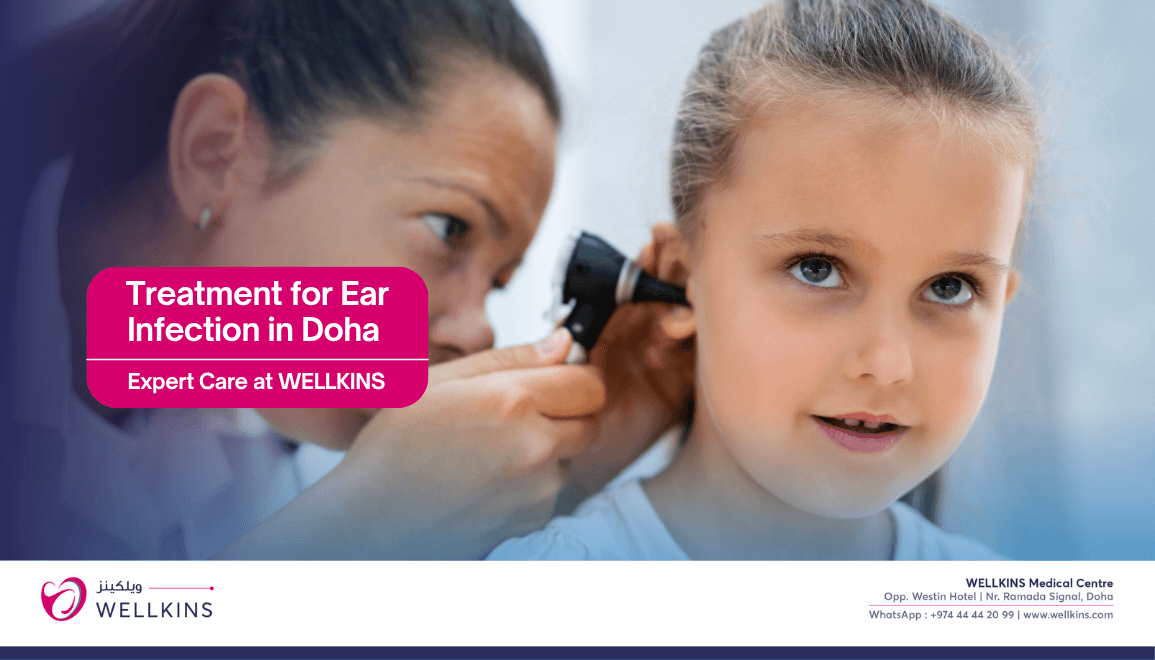
We begin with a specialized visual check of the outer ear canal and most importantly, the eardrum. This allows us to look for key signs of infection, such as bulging, severe redness or visible pus or fluid behind the drum. Next, a functional test assesses the eardrum’s movement. we check how well the eardrum moves. Limited or absent movement strongly suggests that fluid is trapped and pressure is unbalanced in the middle ear space. We use a highly accurate, non-invasive objective test to measure the air pressure and compliance of the middle ear. An abnormal result from this measurement accurately detects the presence of trapped fluid, which is crucial for confirming a diagnosis and planning treatment. If a patient reports ongoing hearing difficulties, we perform additional tests to assess the hearing. This test precisely measures the extent and type of any hearing loss, providing invaluable data for deciding whether more advanced medical interventions may be necessary.
Inclusive and Customized Treatment Options
Treatment is always tailored precisely to the type, severity and causative agent of the ear infection:
Immediate Pain Management: Providing rapid relief from intense ear pain (otalgia) is our first priority. We recommend and prescribe effective analgesics to reduce inflammation. Applying a moist, warm compress or heating pad externally over the ear can also offer significant soothing comfort.
Antibiotics for Bacteria: Antibiotics are the specific and decisive treatment for confirmed bacterial infections, particularly acute Otitis Media and severe Otitis Externa. Outer ear infections are typically treated with topical, high concentration antibiotic ear drops, while middle ear infections require systemic antibiotics. We emphasize the necessity of completing the full prescribed course to prevent relapse and antibiotic resistance.
Strategic Observation (“Watchful Waiting”): For many mild cases of middle ear infection, especially in children over two years old and when the diagnosis is uncertain (potentially viral), we often advise an initial period of “watchful waiting”. This evidence-based approach is crucial for minimizing unnecessary antibiotic use, thereby combating the global rise of antibiotic resistance.
Topical Anti-Inflammatory Agents: In cases of severe outer ear canal swelling and inflammation, specialized ear drops containing a combination of antibiotics and potent anti- inflammatory steroids are highly effective at reducing swelling and alleviating pain quickly.
Proactive Steps for Prevention
Protecting yourself and your children from the pain and inconvenience of ear infections is highly achievable through simple, consistent, health conscious habits.
Up-to-Date Immunization Schedule: This is arguably the single most effective intervention. Ensuring that all family members are fully vaccinated, particularly with the Pneumococcal Conjugate Vaccine (PCV) and receiving the annual Influenza (Flu) Vaccine, prevents the most common bacterial and viral illnesses that initiate Otitis Media.
Rigorous Hand and Respiratory Hygiene: Consistent and proper hand washing with soap and water for at least 20 seconds is crucial for interrupting the cycle of respiratory infection. Additionally, teaching children proper “cough and sneeze etiquette” (into the elbow) minimizes the air and surface transmission of cold and flu viruses.
Eliminate Environmental Toxins: This is non-negotiable: maintain a completely smoke-free environment in your home, car and immediate surroundings. Second-hand smoke is a direct irritant and paralyzer of the tiny cilia that keep the eustachian tube clear, dramatically elevating infection risk.
Safe Water Management for Swimmers: To prevent Otitis Externa, gently dry the outer ear with the corner of a towel immediately after swimming or extended water exposure. Crucially, never insert cotton swabs or any sharp objects into the ear canal which can damage the delicate skin lining.
Proper Infant Feeding Positioning: Always feed infants in a semi-upright or upright position (never lying flat). This simple positional change prevents formula or milk from passively flowing and pooling into the back of the throat, where it could easily reflux up the short eustachian tube and introduce infectious agents into the middle ear.
Active Allergy Control: Work with your doctor to actively manage chronic nasal and throat allergies. Using prescribed nasal sprays or appropriate oral medications during peak allergy seasons prevents the sustained inflammation and congestion that inevitably leads to chronic eustachian tube blockage and fluid accumulation.
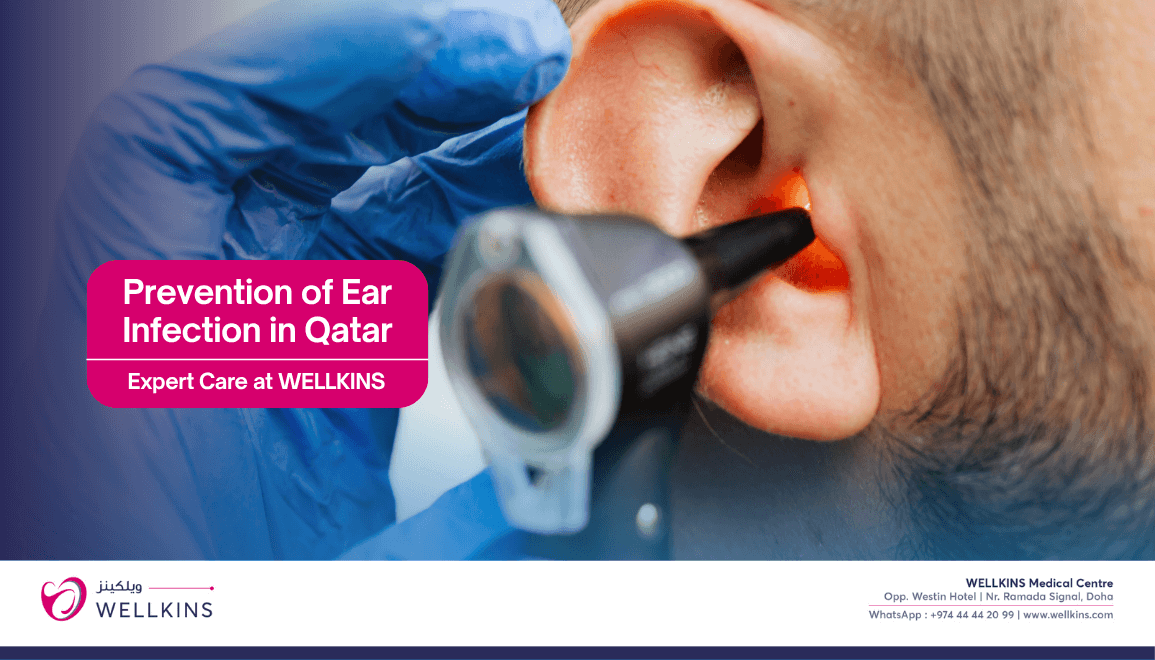
At Wellkins Medical Centre, we fundamentally understand the urgency, significant pain and genuine distress that an ear infection causes, recognizing it as an acute condition demanding immediate and conclusive resolution. Our unwavering commitment to your ear health is rooted in a complete, multi-faceted approach: we ensure swift triage and prioritization for acute pain cases; we perform accurate, evidence-based diagnosis using advanced tools and we deliver effective, targeted treatment, meticulously tailored for rapid symptom relief and complete microbial eradication;
We prioritize inclusive pain management to quickly alleviate throbbing pain and focus on preventing future recurrence through detailed education and risk – mitigation strategies. We are diligent in protecting long-term hearing by actively managing the disease and preventing chronic complications.
To book an appointment at Wellkins: https://wellkins.com/ent/


